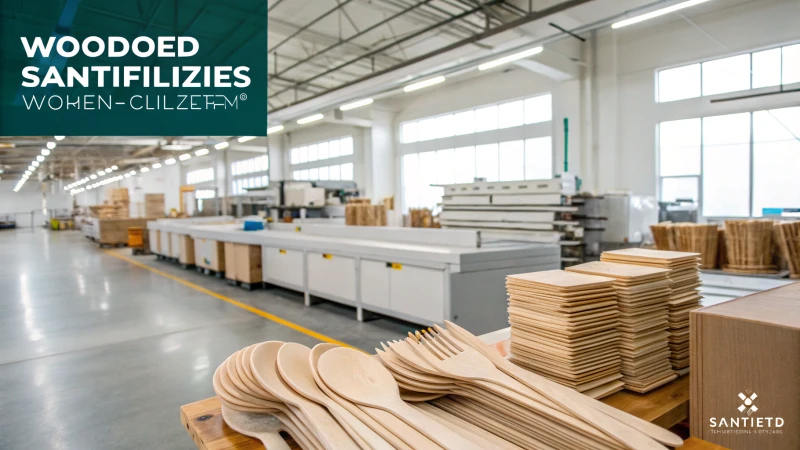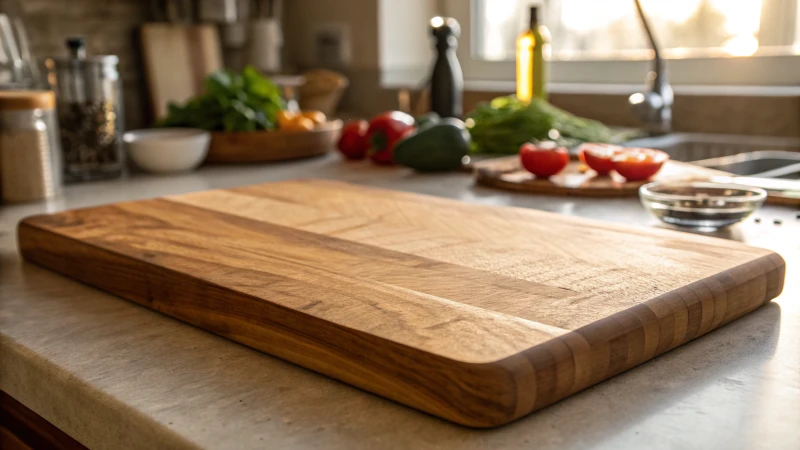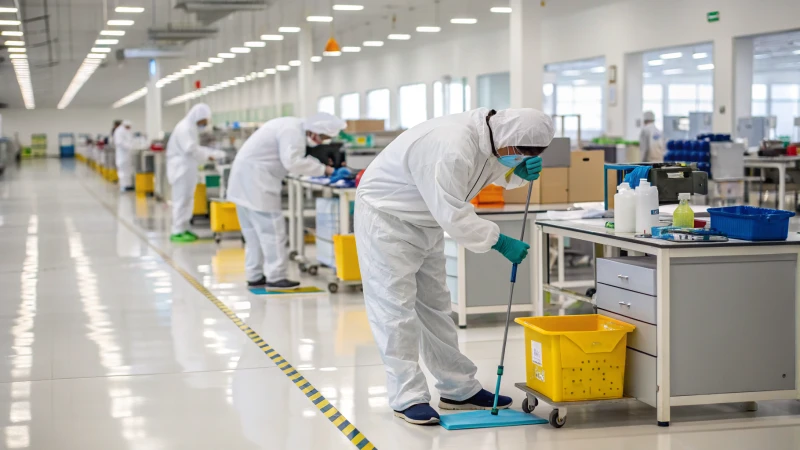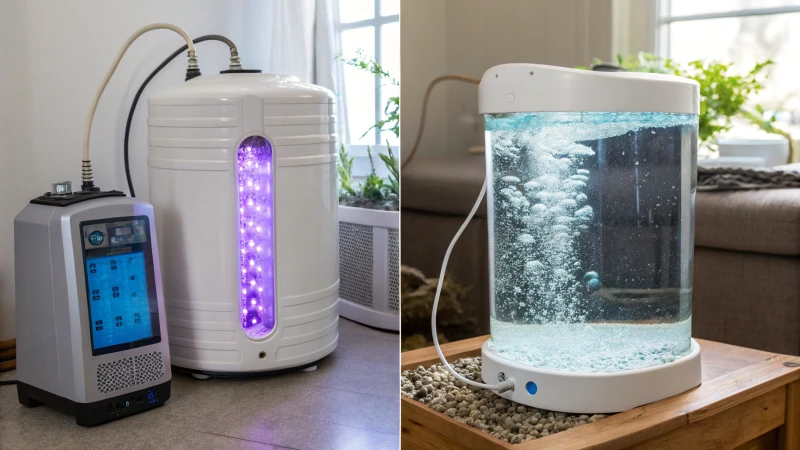
Imagine crafting a dining experience where safety meets sustainability, all with a piece of cutlery.
To ensure sanitary production of disposable wooden cutlery, start by selecting treated wood to avoid contamination, enforce rigorous hygiene standards in manufacturing, and seal the final products in protective packaging.
When I first started exploring the world of sustainable dining, I was amazed by the intricate steps required to make sure each fork and knife not only looks great but is safe to use. It’s like peeling back layers of commitment to quality, starting from the very core—the wood itself. Choosing the right treated wood is crucial; it's the foundation of preventing contamination. But that’s just the beginning. I’ve learned that maintaining strict hygiene protocols during manufacturing is equally essential. Imagine a meticulous dance of precision and care, where every step ensures cleanliness and safety. And finally, it all wraps up with sealing these beautifully crafted items in secure packaging. This final step is like tucking them into bed, ready to meet the world, assuring users of their purity and our commitment to sustainability.
Treated wood prevents contamination in cutlery production.True
Treated wood reduces the risk of microbial contamination, ensuring safety.
Sealed packaging is optional for wooden cutlery.False
Sealed packaging is essential to maintain hygiene and prevent contamination.
How do we keep wood hygienic and safe?
Ever wondered how that beautiful wooden spoon stays safe for your soup or salad?
Wood is treated hygienically using heat treatment, chemical sanitization, and surface coatings. These techniques effectively eradicate bacteria, fungi, and contaminants, ensuring the wood is safe for use in diverse settings.

Understanding Wood Treatment Techniques
When it comes to keeping wooden products hygienic, especially in places like restaurants or hospitals, I've found that a combination of methods works best. We often use heat treatment1, chemical sanitization, and surface coating. Let me tell you why each is crucial:
-
Heat Treatment: Imagine it as giving the wood a hot bath. It gets exposed to high temperatures to kill off any pesky germs. I love this method because it not only cleans but also strengthens the wood.
-
Chemical Sanitization: Sometimes, a bit of chemistry is needed. Using agents like quaternary ammonium compounds, we can disinfect surfaces effectively. They're great at getting rid of bacteria and fungi.
-
Surface Coating: This is like putting a protective jacket on the wood. With food-safe varnishes or waxes, we create a barrier against moisture and microorganisms.
Comparing Treatment Methods
Here's how these methods stack up:
| Method | Pros | Cons |
|---|---|---|
| Heat Treatment | Chemical-free, enhances durability | Energy-intensive |
| Chemical Sanitization | Effective against a wide range of pathogens | Potential chemical residue concerns |
| Surface Coating | Provides a protective barrier | May require reapplication over time |
Practical Applications
In my line of work, I've seen how these methods play out. Take restaurants2—they often opt for chemically sanitized wooden utensils for quick turnarounds during busy hours. Imagine juggling orders while ensuring every piece is safe! Meanwhile, in hospitals, sterile wooden tongue depressors with specific coatings3 are a must to keep things hygienic for patients. It's all about maintaining high standards while keeping everyone safe.
Ensuring Compliance and Sustainability
It's not just about hygiene; meeting regulatory standards is key too. I always check for certifications like the Forest Stewardship Council (FSC) to ensure sustainable sourcing. Plus, opting for eco-friendly chemicals fits perfectly with our sustainability goals. This choice resonates well with eco-conscious customers, and I believe it sets us apart.
By grasping these processes, businesses can make informed choices about their suppliers, ensuring that treated wood products meet both hygiene and sustainability needs. For stakeholders like procurement officers4 and supply managers5, this understanding is crucial to ensure compliance and quality in their operations.
Heat treatment enhances wood durability.True
Heat treatment sterilizes wood and improves its structural integrity.
Chemical sanitization leaves no residue on wood.False
Chemical sanitization may leave residues, raising safety concerns.
How Do Manufacturing Sanitation Protocols Ensure Cleanliness?
Imagine walking into a factory where cleanliness is so palpable, it feels like you could eat off the floors. That's the power of effective sanitation protocols in manufacturing.
Sanitation protocols in manufacturing involve rigorous cleaning procedures, approved disinfectants, frequent inspections, and strict employee hygiene standards. These steps are essential to uphold cleanliness and prevent contamination in production environments.

Understanding Sanitation Protocols
When I think about sanitation in manufacturing, particularly in sectors like food processing, it feels like a meticulous dance of procedures that ensure everything stays spotless and safe. From my experience visiting various factories, these protocols are non-negotiable—they're the backbone of product safety and quality. They encompass detailed cleaning procedures6, regular upkeep of equipment, and stringent hygiene standards for employees.
Cleaning and Disinfecting
One thing that always stands out to me is the importance of cleaning and disinfecting. I remember walking through a production line where workers were methodically using approved cleaning agents, scrubbing away any trace of dirt or debris. It's like watching artists at work—each swipe with detergents to remove grease or sanitizers to cut down bacteria ensures every surface is pristine.
| Cleaning Agents | Purpose |
|---|---|
| Detergents | Remove grease and soil |
| Sanitizers | Reduce bacteria to safe levels |
| Disinfectants | Kill or inactivate harmful organisms |
Scheduled cleanings are not just routines; they're vital rituals to keep surfaces contaminant-free, minimizing any risk of cross-contamination.
Regular Inspections
I've seen firsthand how regular inspections transform potential chaos into calm orderliness. These inspections are the unsung heroes of maintaining sanitation standards. Imagine conducting daily checks focusing on high-touch surfaces, then scaling up to weekly audits for all equipment and monthly reviews to assess sanitation effectiveness. This vigilance helps nip potential issues in the bud before they can snowball into bigger problems.
- Daily checks: Zero in on high-touch areas and surfaces.
- Weekly audits: Dive deep into comprehensive equipment inspections.
- Monthly reviews: Evaluate overall sanitation effectiveness.
Employee Hygiene Practices
Employee hygiene is another aspect that can't be overstated. I once met a factory manager who told me that maintaining high hygiene standards among employees was akin to ensuring the whole operation's success. They enforce hand-washing policies, supply PPE, and provide ongoing training on best hygiene practices. It's clear that when employees commit to these protocols, it directly uplifts the cleanliness of the entire production environment.
Monitoring and Reporting
Technology has revolutionized how we monitor sanitation. I find it fascinating how sensors and software solutions now track cleaning processes meticulously. They gather data that helps analyze and enhance sanitation practices continuously.
| Monitoring Tool | Functionality |
|---|---|
| Sensors | Detect surface contamination |
| Software solutions | Track cleaning schedules |
| Data analytics | Analyze sanitation efficiency |
This tech-driven approach provides actionable insights that help manufacturers refine their sanitation strategies.
Compliance with Regulations
Finally, regulatory compliance is a cornerstone of sanitation protocols. I’ve seen how adhering to guidelines from agencies like OSHA ensures products are safe and trustworthy.
- OSHA standards: Set the groundwork for safe manufacturing practices.
- Local regulations: Provide additional guidelines based on regional laws.
- Industry certifications: Enhance credibility through voluntary standards.
Staying updated with these regulations isn't just about ticking boxes; it's about securing consumer safety and elevating a brand’s reputation globally through robust sanitation protocols7.
Sanitizers kill all bacteria on surfaces.False
Sanitizers reduce bacteria to safe levels but do not kill all bacteria.
OSHA provides guidelines for manufacturing sanitation.True
OSHA outlines requirements for safe manufacturing practices, including sanitation.
How Does Packaging Play a Role in Maintaining Cleanliness?
Ever stopped to think about how the packaging of your favorite products keeps them safe and clean? It's a fascinating story.
Packaging plays a crucial role in maintaining cleanliness by acting as a barrier against contaminants, preserving product sterility, and ensuring safe transportation. Effective packaging design and material choice are essential for maintaining hygiene.

Packaging as a Protective Barrier
I remember the time I visited a bustling food market, where vendors were selling everything from fresh produce to homemade jams. It struck me how essential packaging was in keeping everything fresh and uncontaminated amidst the chaos. Packaging serves as the first line of defense against contaminants, protecting products from dust, bacteria, and other harmful substances. In industries like food and pharmaceuticals, packaging must meet stringent hygiene standards8. For example, vacuum-sealed bags keep food fresh by removing air, which inhibits bacterial growth.
Material Matters
Choosing the right material for packaging is like picking the perfect outfit for an important meeting—it matters! Biodegradable materials like PLA (polylactic acid) not only support sustainability but also offer hygienic benefits. They decompose naturally without leaving harmful residues. Conversely, traditional plastics can harbor bacteria if not properly sanitized.
| Material Type | Hygienic Properties | Environmental Impact |
|---|---|---|
| Glass | Non-porous, easy to sterilize | Recyclable, energy-intensive |
| Biodegradable PLA | Eco-friendly, reduces waste | Compostable |
| Aluminum | Resistant to contamination | Recyclable, durable |
Innovations in Packaging Design
I once attended a seminar where they showcased the latest in packaging innovations. It was like watching a magic show—seals that change color if tampered with, resealable closures that keep everything pristine until the moment of use. Modern packaging design incorporates features like tamper-evident seals and resealable closures, ensuring products remain untouched until use. These designs are crucial for maintaining the sterility of medical supplies and pharmaceuticals. Innovations such as antimicrobial packaging actively reduce the presence of pathogens on surfaces.
The Role of Packaging in Transportation
During transportation, packaging must withstand various environmental conditions while keeping the product clean and intact. Imagine sending a gift across the globe—only to find it ruined by moisture or impact! Shock-absorbent materials protect contents from physical damage, while moisture-resistant coatings prevent contamination from humidity or spills.
Adapting to Global Standards
In today’s interconnected world, adapting to global packaging standards is crucial. I once faced this challenge head-on when coordinating an international shipment of products that had to meet diverse standards across countries. Manufacturers must adapt to global packaging standards to ensure product cleanliness across borders. Standards like ISO 220009 set guidelines for food safety management, including packaging requirements. Compliance with such standards reassures consumers about product safety.
Understanding the complex role of packaging in maintaining cleanliness helps businesses meet customer expectations for hygiene and quality. Whether it's selecting the right materials or employing innovative design features, effective packaging is essential for safeguarding product integrity in today's market.
Biodegradable PLA is compostable.True
PLA decomposes naturally, making it compostable and eco-friendly.
Glass packaging is porous.False
Glass is non-porous, which makes it easy to sterilize and hygienic.
How is Water Disinfected Before It Reaches Our Taps?
Ever wondered what goes into making sure the water you drink is safe?
Before water reaches your tap, it undergoes final disinfection through methods like chlorination, ozonation, or ultraviolet (UV) treatment. These techniques effectively kill bacteria and viruses, ensuring the water is safe to drink.

Chlorination
I remember the first time I learned about chlorination; it was during a college project on water safety. Chlorination is fascinating in its simplicity yet impressive effectiveness. It's like adding a protective shield to the water—by introducing chlorine or chlorine compounds like sodium hypochlorite or calcium hypochlorite, we ensure that any pathogens are neutralized and stay that way throughout distribution.
| Pros | Cons |
|---|---|
| Cost-effective | Can produce by-products like trihalomethanes (THMs) |
| Long-lasting residual effect | Potential taste and odor issues |
Learn more about chlorination10.
Ozonation
Now, ozonation is another beast entirely. Picture a powerful oxidant—ozone gas—being generated on-site and injected into water through a special chamber. This method intrigued me because it leaves no residue, which means no odd tastes or odors. But, it does require significant energy and complex equipment, something I realized while visiting a local treatment plant. The effort is worth it, though, for the purity it delivers.
- Advantages: Leaves no residue or by-products, enhancing taste and odor.
- Disadvantages: High energy consumption, requires complex equipment.
Learn more about ozonation technology11.
Ultraviolet (UV) Treatment
UV treatment was a revelation. Imagine water passing through UV light, instantly disrupting the DNA of microorganisms. It's like science fiction, but it's real and effective against bacteria, viruses, and protozoa without using any chemicals. The downside? There's no lingering disinfectant effect, so it needs precise monitoring—something I came to appreciate after seeing the meticulous checks at work in a friend's lab.
- Advantages: No chemical use, no change in taste or odor.
- Disadvantages: No residual disinfectant effect, requiring careful monitoring.
For detailed insights into UV treatment12, consider exploring additional resources.
Choosing the right disinfection method depends on various factors like water quality and cost. Understanding these methods13 is crucial for making informed decisions that impact public health and environmental sustainability.
Chlorination leaves no residual effect in water.False
Chlorination is known for its long-lasting residual disinfectant effect.
UV treatment alters the taste of water.False
UV treatment does not use chemicals, so it does not alter water taste.
Conclusion
Essential sanitation practices for producing disposable wooden cutlery include selecting treated wood, maintaining strict hygiene during manufacturing, and ensuring protective packaging to prevent contamination.
-
Learn how heat treatment kills pathogens in wood, enhancing its safety and durability. ↩
-
Discover why chemically sanitized wooden utensils are favored in restaurants for hygiene. ↩
-
Explore how specific coatings ensure hygiene in wooden medical tools. ↩
-
Understand why FSC certification is crucial for sustainable wood sourcing. ↩
-
Learn how supply managers maintain compliance and quality with treated wood products. ↩
-
Learn how different cleaning methods ensure product safety by preventing contamination in manufacturing. ↩
-
Explore detailed guidelines on implementing effective sanitation protocols in food manufacturing. ↩
-
Explore this link to understand how different industries implement hygiene standards in their packaging processes. ↩
-
This link provides insight into international standards for food safety management, focusing on how packaging contributes to maintaining product cleanliness. ↩
-
Explore how chlorination effectively disinfects water and maintains safety during distribution. ↩
-
Understand the advantages of using ozone as a disinfectant and its impact on water quality. ↩
-
Discover the effectiveness of UV light in inactivating microorganisms without chemical use. ↩
-
Gain insights into various disinfection methods to determine the most suitable for your needs. ↩

